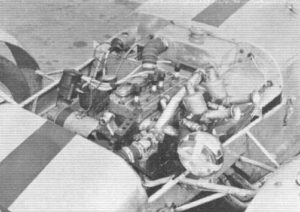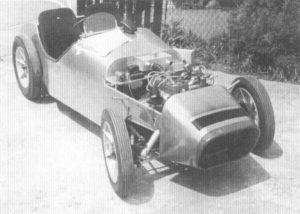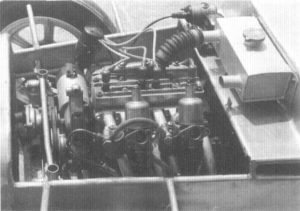
Stupendous 750
Reprinted from CARS ILLUSTRATED, November 1959 – page layout changed slightly.

The Speedex 750 based on an early Austin Seven chassis is quite a trim, purposeful little machine. Magnesium alloy wheels replace the standard Austin Seven wire wheels and there are not many other unmodified parts. Bodywork is of aluminium and there are no doors; the latter, however, are not necessary, for any but the least agile can lift his leg above the low height of the sill.
IN the 750 world this season one of the most successful (it won the Goodacre Trophy) and one of the most reliable cars has been Jem Marsh’s Austin Seven Special (of Speedex fame). Recently we went along to Brands Hatch to have a look at this car and drive it around the track. It seems astonishing that it was basically a 1933 Nippy sports before Speedex got to work on it. They boxed the chassis and fitted a tubular crossmember and a tubular diagonal member for extra strength; these modifications are normally bolted on and are easily fitted by the enthusiasts although on this particular car they had been welded in position. Aft of the chassis was bolted a further sub frame (for pre-Ruby chassis only) to rake the shock absorber upper mounts and battery box.
The car was fitted with the Speedex independent front suspension system comprising a transverse leaf spring and parallel wishbones which bolt straight on to the Austin Seven chassis. At the rear, special flattened springs are used in conjunction with hydraulic dampers; the latter fit on to brackets bolted to the axle. The normal Austin Seven steering is used although steering arms and links are modified to give correct kingpin angle. A main Austin Seven worry has been overcome by converting to Morris Minor Lockheed hydraulic brakes on all four wheels. They worked extremely well.
During the season this particular car has achieved five first places, one second, and one fourth; it has lapped Brands Hatch consistently in 1 min. 12.5 sec. and has proved to be entirely reliable throughout the season – all this with an engine designed some 30 years ago. Actually the engine in this car is one of the rare Speedy types with a fully pressurised oil lubrication system for the crankshaft. It was removed from a clapped-out vehicle some years back after having motored for thousands of miles only to motor for many more race miles after having received considerable attention. Every item is balanced and in some cases lightened; a finned aluminium head is fitted which raises the compression ratio to 7.2:1. Over-sized valves and double valve springs increase the rev limit and carburetion is by two 1 1/8 in. S.U. carburettors. Speedex manifolding is used in conjunction with a Servais silencer.

Driving compartment of the Speedex 750 is somewhat tight although Jem Marsh manages to squeeze his 6ft 3in in without any trouble. Once in, however, one feels quite at home. Visible below the steering wheel is part of the original A7 chassis
When trying this car we were advised not to go beyond 5,000 r.p.m. although during an actual race the engine is taken to 6,000 r.p.m. but even with this limit we were struck by the spirited performance. The 5.125:1 rear axle ratio in conjunction with the Speedex cast aluminium wheels and a close ratio gear box provides some 15 m.p.h. per 1,000 r.p.m. in top gear. The engine revved astonishingly easily and the car was a delight to drive. It handled extremely well and it was well nigh impossible to make the rear break away. Incidentally in spite of the cars’ small dimensions it is quite easy for Jem Marsh of Speedex to slip behind the wheel and he is 6 ft. 3 in., although perhaps anyone taller than this would not be able to get in at all. Once inside the car everything is close to hand and there is no chance of being hurled about during cornering We came away from Brands wondering how much longer the Austin Seven will be called upon to serve as a basis for fast, albeit perhaps a little stark, sporting machinery for the impecunious enthusiast. As long as Speedex are in business these machines will no doubt continue to thrive—literally everything in the way of speed equipment can be bought from this Luton speedshop.-D.S.

Fitted with one of the rare pressurised crankshaft engines which has been modified almost beyond recognition, the Speedex 750 has an amazing turn of speed. All the speed equipment visible in this picture can be bought off the shelf at Speedex Accessories Ltd.
Stupendous 2
Reprinted from the 1982B issue of the Austin Seven Clubs Association magazine with kind permission of the Editor, Barry Lovelock. Pictures scanned, text transferred by OCR

The car not owned by the author – BNM 369, the car Jem Marsh used to win the Goodacre Trophy in 1959
For some months my wife had been pointing out the obvious as I negotiated the obstacle course that separated one side of my garage from the other, “You’ve got too much clutter, why don’t you get rid of what you don’t need and make room for yourself to work?”
It was my collection of Chummy bits that got the chop and as Nick Morgan drove off with them one Saturday afternoon, I was left standing in a lovely clear space with a cheque burning a hole in my pocket. Money tends to have that effect on my clothing and I was already turning over in my mind the fact that there was an Autojumble in the small Devon town of Hatherleigh the following Monday. Being a Bank Holiday I popped across in search of Austin 7 goodies and that was how I came to see an almost illegible pencilled note pinned to a cowshed door announcing that someone had a 1936 Austin 7 Special for sale.
“It’s a very fast one,” the vendor assured me. “And it’s as good as new”. (Aren’t they all?) When he said it was garaged in Plymouth, that almost finished me because I had already travelled a considerable distance to look at a “very fast” Austin in that city which had turned out to be load of junk with an asking price that ran into thousands. I was convinced it must be the same vehicle, but persevered and that same evening, as the door of the lock-up garage opened, my eyes nearly fell out of my head. I feel that an account of the rare car that I took home that night might be of interest to Austineers.
To forestall those who write in the next edition to point out that I don’t know what I’m talking about, let me make it clear that I don’t. I had never heard of the car in question until I spoke to Chris Gould and by then had already started taking it to pieces to use the go-faster bits on my Ulster replica. For my technical data I rely on an article in Cars Illustrated (Nov. 1959) under the heading “Stupendous Seven from Speedex” – thank you Chris.
I must also make it clear that my car is not BNM 369 used by Jem Marsh to win the Goodacre Trophy in 1959 by way of five first places, one second and one fourth. My car, JG 7874, appears, however, to be almost identical, brand new and not even finished off. The engine has a finned aluminium cylinder head which raises the compression ratio to 7.2:1 and a deep finned aluminium sump. Oversize valves are supplied through a Speedex, separate pipe manifold which is adorned with twin l 1/8” S.U. carbs. The crankshaft is a Speedy type and fully pressure lubricated, and the clutch has beefed up springs. A Ford water pump forces coolant through a low, crossflow aluminium radiator and the system is topped up by a scuttle mounted header tank


A sports coil feeds a special Lucas distributor and an initial examination of the engine suggests that it has never been run at least since it was rebuilt in Speedex form. The gearbox is a close ratio, four-speed model with a remote change lever which seems to provide a firm positive change of cogs. In the Marsh car an identical box coupled with the 5.125:1 rear axle produced 15 m.p.h per thousand revs and consistent revving to 6000 r.p.m. produced no mechanical failures in the season that it took the Goodacre Trophy. The chassis frame, a long one, is much lower than standard – a result that has been attained by modified front and rear suspension. The forward end has a flat leaf spring with Panhard rods from the centre line to the bottom end of each stub axle and telescopic shock absorbers. The front track is 4″ wider than standard and retardation is provided by a Bowden conversion (rather than hydraulics used on the Marsh car), but my system is the lighter of the two and appears to provide as much stopping power as the kingpins can cope with. The rear suspension is standard except that it has been fitted with telescopic dampers and much thinner (flat) spring leaves, which result in a further saving of weight. The Ruby tank provides fuel by way of an electric pump mounted under the passenger’s seat and a further increase in lightness has been achieved by not boxing-in the whole of the chassis frame – as was done on Marsh’s car. Boxing-in seems to be a popular modification, but I have serious doubts about the benefits that it provides and it can make life a nightmare when working on the car.
The extremely light body is made of thin aluminium panels riveted to a tubular space frame which provides a remarkable degree of rigidity and its `Vanwall” lines are set off by pretty cast aluminium 15″ wheels. I am, incidentally, searching desperately for an identical wheel to use as a spare. I know little of the history of the car except that for the last three years it has been in the garage at Plymouth and for the previous 15 was somewhere in the Wedmore area of Somerset. I would be delighted to hear from anyone who can enlarge on these bare facts. The car is now nearly roadworthy, and I’m determined that it will be a force to be reckoned with in 1982 and I still can’t move in the garage.
Russell Kingsford-Curram


